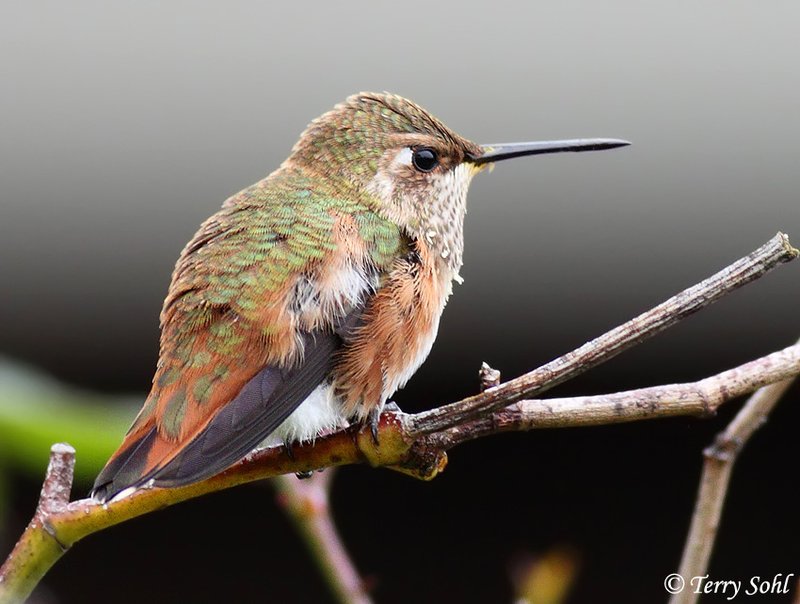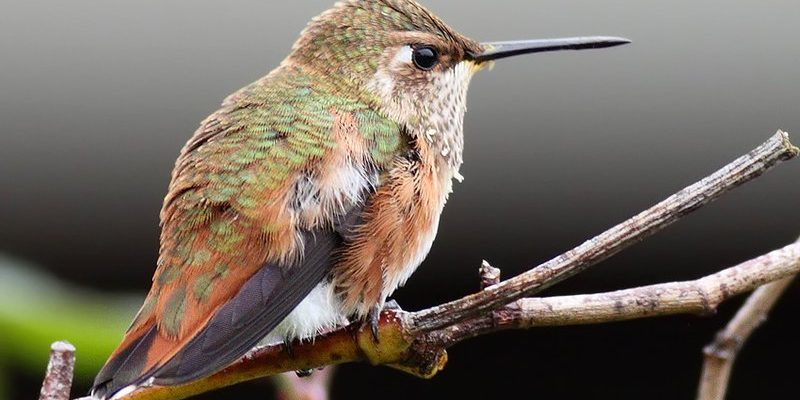
The Rufous Hummingbird is one of the most captivating little creatures you’ll ever encounter. Imagine a tiny, jewel-like bird flitting through the air, its wings humming at an incredible speed while it sips nectar from vibrant flowers. With its striking orange and green plumage, this bird is not just a treat for the eyes; it’s also a marvel of nature. Known for its bold personality and migratory habits, the rufous hummingbird brings a splash of color and energy to gardens and natural landscapes alike.
If you’ve ever paused to marvel at a hummingbird hovering in mid-air, you might have found yourself wondering about its incredible capabilities. The rufous hummingbird, in particular, is renowned for its long migrations and territorial behavior. It travels thousands of miles each year, showcasing its resilience and adaptability. Whether you’re an avid birdwatcher or just someone who enjoys the beauty of nature, getting to know the rufous hummingbird can deepen your appreciation for this amazing species.
Physical Characteristics
One of the first things you’ll notice about the rufous hummingbird is its stunning coloration. Adult males are easily recognized by their vibrant, fiery orange feathers that cover most of their bodies. Their iridescent green backs and throats add a striking contrast, making them look almost like flying gems. Female rufous hummingbirds, on the other hand, have a more muted palette, with green and brown tones, which helps them blend into their surroundings—an essential trait for nesting.
In terms of size, these hummingbirds are relatively small. Typically, they measure around 3 to 4 inches in length. Despite their diminutive size, their wings beat at an astonishing rate of about 50 to 100 times per second, allowing them to hover and dart around with remarkable agility. This efficiency is part of what makes them such expert nectar feeders.
Another interesting aspect of their anatomy is their long, specialized bills which allow them to reach deep into flowers to access nectar. This long bill not only aids their feeding but also plays a crucial role in pollination, as they transfer pollen from one flower to another. It’s a symbiotic relationship that benefits both the hummingbirds and the plants they visit.
Habitat and Range
The Rufous Hummingbird is primarily found in North America, particularly in the western parts of the continent. During breeding season, they make their homes in forests, meadows, and gardens where flowering plants are abundant. They prefer elevated areas, often nesting in mature pine or fir trees, but can also be spotted in backyards and urban gardens that provide food and shelter.
When it comes to migration, rufous hummingbirds are remarkable. They embark on one of the longest migratory routes of any hummingbird species, traveling from breeding grounds in Alaska and Canada all the way to their wintering habitats in Mexico. This journey can cover over 3,000 miles and is not for the faint of heart. They make this trek alone, facing various challenges such as changes in weather and food availability.
During migration, these birds exhibit incredible navigation skills. They are known to follow mountain ranges and stay close to water sources, ensuring they can find food along the way. Their ability to adapt to different environments contributes to their success as a species, enabling them to thrive in various habitats across North America.
Diet and Feeding Habits
The diet of the rufous hummingbird primarily consists of nectar from flowers, but they are also insectivorous. They need this combination to maintain their high energy levels, as they are constantly on the move. When you think of hummingbirds, the image of them hovering by a flower comes to mind; however, they are also excellent hunters. Small insects and spiders provide essential protein that helps them during breeding season and when raising their young.
These birds have excellent memories, allowing them to remember which flowers have been recently visited. This means they can optimize their feeding by seeking out the flowers that contain the most nectar. Additionally, they are known to defend their feeding territories vigorously, often chasing away other birds from their favorite spots. This fierce competitiveness ensures they have access to enough food to sustain their high-energy lifestyle.
Interestingly, rufous hummingbirds also play a key role in pollination. As they flit from flower to flower, their heads brush against the reproductive parts of the plants, transferring pollen and helping them reproduce. This mutualistic relationship is essential for the health of many flowering plants in their habitats, fostering biodiversity and supporting the ecosystems they inhabit.
Behavior and Social Structure
Rufous hummingbirds are known for their bold and aggressive behavior, especially during breeding season. Males will often engage in spectacular aerial displays to attract females, showcasing their agility and strength. These displays can include rapid dives, sharp turns, and even vocalizations that add to their dramatic presence. Males are highly territorial and will fiercely defend their feeding areas against other males, sometimes leading to intense aerial battles.
In contrast, female rufous hummingbirds are more focused on nesting and raising their young. After mating, they will build nests, often using plant materials, spider silk, and feathers to create a soft and secure environment for their eggs. Females are solely responsible for caring for the young, feeding them a mixture of nectar and insects until they are ready to fledge.
Socially, rufous hummingbirds are generally solitary, except during mating season. Their inclination towards individualism can make them seem aloof, but that’s simply their nature. Each bird is focused on survival—be it through feeding or competing for mates—which is crucial given their energetic lifestyle.
Conservation Status
Currently, the Rufous Hummingbird is classified as a species of least concern, which means they are not currently facing any immediate threat of extinction. However, it’s important to remember that environmental changes can impact their populations. Habitat loss, climate change, and the decline of flowering plants due to development and pollution can disrupt their feeding and breeding grounds.
Conservation efforts are essential to ensure that these beautiful birds continue to thrive. Setting up backyard gardens that provide nectar-rich flowers can significantly aid in supporting their populations. By planting native plants that bloom at different times throughout the season, you can create a safe haven for rufous hummingbirds and other pollinators.
Additionally, learning about the migratory patterns and habitats of rufous hummingbirds can help inform conservation strategies. Working to preserve their natural environments ensures that future generations can enjoy the beauty and wonder of these incredible birds. Every effort counts, whether it’s a small garden or large-scale habitat restoration project.
Interesting Facts
| Size: | 3 to 4 inches in length |
| Wingspan: | 4 to 5 inches |
| Weight: | 3 to 4 grams |
| Migration Distance: | Up to 3,000 miles |
| Life Span: | 3 to 5 years in the wild |
| Nectar Sources: | Trumpet vine, bee balm, and honeysuckle |
FAQ
What do Rufous Hummingbirds look like?
Rufous Hummingbirds are easily identified by their bright orange feathers, especially in males, who flaunt vibrant orange on their backs and bellies. Females are more toned down, sporting green and brown hues that help them camouflage in their environment. Both genders have iridescent throats that can catch the light beautifully, making them a delight to watch in gardens or wildflower fields.
Where can I find Rufous Hummingbirds?
You can typically find rufous hummingbirds in western North America. They prefer habitats that include dense flowering plants, which provide them with the nectar they need. During migration, they can be spotted as far south as Mexico, but in spring and summer, they return north to breed, often to regions that include Alaska and Canada.
How do Rufous Hummingbirds migrate?
These impressive little birds migrate solo, covering extensive distances each year. They usually start their journey in late summer, flying thousands of miles from their northern breeding grounds to winter habitats in Mexico. They rely on their keen navigation skills, often following mountain ranges and water sources to find their way, stopping to feed along the way to replenish their energy.
What do Rufous Hummingbirds eat?
The primary diet of rufous hummingbirds consists of nectar from flowers, but they also consume small insects and spiders for protein. Their long bills make it easy to reach deep into flowers for nectar, and they are known for their ability to remember which flowers they have already visited, ensuring they get the most nourishment.
Are Rufous Hummingbirds aggressive?
Yes, rufous hummingbirds are known for their bold and territorial behavior. Males, in particular, are quite aggressive during breeding season, often defending their feeding areas fiercely from other males. They engage in dramatic aerial displays to ward off competitors, showcasing their strength and agility.
How long do Rufous Hummingbirds live?
In the wild, rufous hummingbirds typically live for about 3 to 5 years. However, factors such as predation, environmental conditions, and availability of food can affect their lifespan. It’s interesting to note that female hummingbirds often face more challenges as they invest significant energy in nesting and raising their young.
Can I attract Rufous Hummingbirds to my garden?
Absolutely! You can attract rufous hummingbirds to your garden by planting a variety of nectar-rich flowers, such as trumpet vine, bee balm, and hummingbird sage. Consider adding a hummingbird feeder filled with sugar-water solution to provide a consistent food source. Placing the feeder near blooming plants can increase your chances of spotting these birds as they visit your garden.
What role do Rufous Hummingbirds play in pollination?
Rufous hummingbirds are essential pollinators within their ecosystems. As they feed on nectar from various flowers, they transfer pollen from one blossom to another. This process is vital for plant reproduction and contributes to the overall health and diversity of plant species in their habitats.
Do Rufous Hummingbirds have any special adaptations?
Yes, rufous hummingbirds have several fascinating adaptations that help them survive in their environments. Their specialized long bills are perfect for accessing nectar from deep flowers. Additionally, their incredible wing structure allows for rapid flight and hovering, making it easier for them to navigate and forage effectively.
How can I help protect Rufous Hummingbirds?
You can help protect rufous hummingbirds by creating a friendly habitat in your yard, planting native flowering plants, and avoiding pesticides that can harm beneficial insects. Supporting conservation initiatives that focus on preserving natural habitats will also have a positive impact on their populations.

